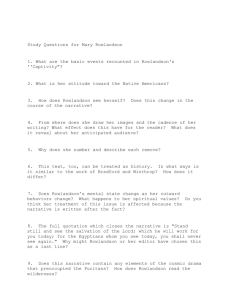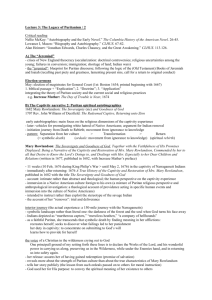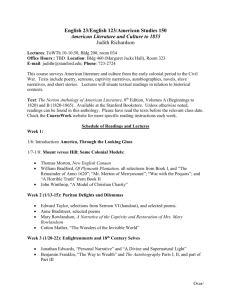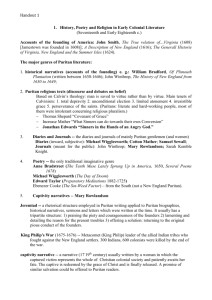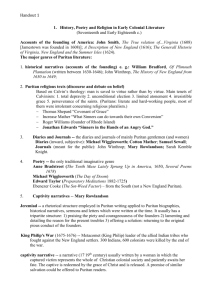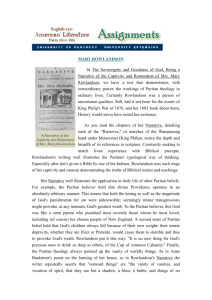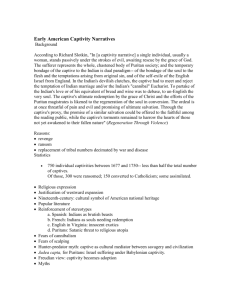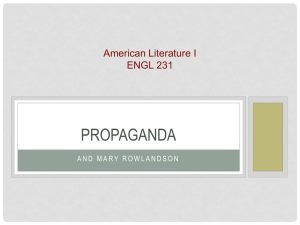Mary Rowlandson's essay - Rubye Richard's Writing Portfolio
advertisement
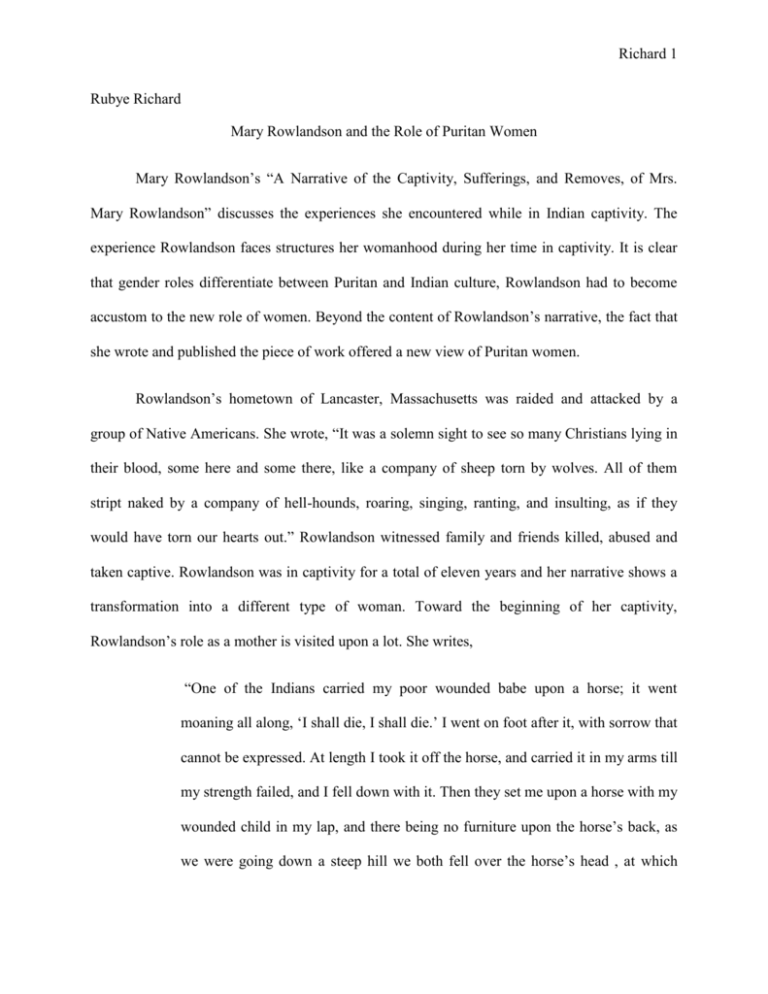
Richard 1 Rubye Richard Mary Rowlandson and the Role of Puritan Women Mary Rowlandson’s “A Narrative of the Captivity, Sufferings, and Removes, of Mrs. Mary Rowlandson” discusses the experiences she encountered while in Indian captivity. The experience Rowlandson faces structures her womanhood during her time in captivity. It is clear that gender roles differentiate between Puritan and Indian culture, Rowlandson had to become accustom to the new role of women. Beyond the content of Rowlandson’s narrative, the fact that she wrote and published the piece of work offered a new view of Puritan women. Rowlandson’s hometown of Lancaster, Massachusetts was raided and attacked by a group of Native Americans. She wrote, “It was a solemn sight to see so many Christians lying in their blood, some here and some there, like a company of sheep torn by wolves. All of them stript naked by a company of hell-hounds, roaring, singing, ranting, and insulting, as if they would have torn our hearts out.” Rowlandson witnessed family and friends killed, abused and taken captive. Rowlandson was in captivity for a total of eleven years and her narrative shows a transformation into a different type of woman. Toward the beginning of her captivity, Rowlandson’s role as a mother is visited upon a lot. She writes, “One of the Indians carried my poor wounded babe upon a horse; it went moaning all along, ‘I shall die, I shall die.’ I went on foot after it, with sorrow that cannot be expressed. At length I took it off the horse, and carried it in my arms till my strength failed, and I fell down with it. Then they set me upon a horse with my wounded child in my lap, and there being no furniture upon the horse’s back, as we were going down a steep hill we both fell over the horse’s head , at which Richard 2 they, like inhumane creatures, laughed, and rejoiced to see it, though I thought we should there have ended our days, as overcome with so many difficulties.” This passage from Rowlandson’s narrative captures the maternal spirit within her and highlights the process of grieving within her society. This passage is from the second remove, so Rowlandson was still very much accustomed to Puritan culture and their role of women. Even during her captivity, she embraced those roles. Rowlandson’s role as a woman in her Puritan culture took the emphasis off self and focused on the need of others. Rowlandson was a wife and a mother, and she embraced her roles. Outside of her family, her role in society was not that significant. She no longer was in the position of taking care of her family because they were all separated, yet her sewing skills is what kept her alive. She was able to help the Indians in a way and they benefited from her presence in captivity. Once again, Rowlandson’s existence relied on how she could benefit others. While in captivity, she also took a feminist outlook on every grievance she encountered. She portrayed herself in a meek and mild manner, as a woman stereotypically should. She wrote, “Yet the Lord still shewed mercy to me, and helped me; and as he wounded me with one hand, so he healed me with the other.” Instead of being upset with her current state in captivity and be angry toward the Indians, she held onto her faith in God. She viewed her experience as being God’s will, whether it was good or bad, she trusted the will of God. It is evident in this account of her narrative. Although she is still held in captivity and she is wounded, she believes God is looking out for her. She meets Robert Pepper and through their interaction, he helps mend her wounds with the use of oak leaves. It is not until after captivity that Rowlandson becomes a new woman of the seventeenth century. Richard 3 Once Rowlandson returned to Lancaster, she began to write down her experiences prior to, during and after captivity, but it was not until years later her narrative became published. By Rowlandson publishing her narrative, she spoke volumes to her society. Although at the time, her intention in writing her narrative was to make a name for herself, she did, and she became a part of history as a woman. Rowlandson’s narrative allowed her to have a voice within the Puritan society. Women were not looked upon in the highest respects and it was men who held the noblest positions. Men had a voice and in literature, women characters where created on the basis on male beliefs. Rowlandson gave an accurate account of a woman’s journey and experiences. Women in the seventeenth century had minimal significance in society and Rowlandson’s narrative is the first account written of a Puritan woman, by a Puritan woman. She became the catalyst of the feminist movement. With Mary Rowlandson’s narrative, she made a bold statement about the lives of women in the seventeenth century without even knowing it at the time. Her narrative became a part of history because it is one of the first records of a woman captivity narrative; consequently, it sparked a new genre where women were able to dominate over men. Rowlandson transformed the image and existence of women and will remain an influential part of woman’s and literature history.

